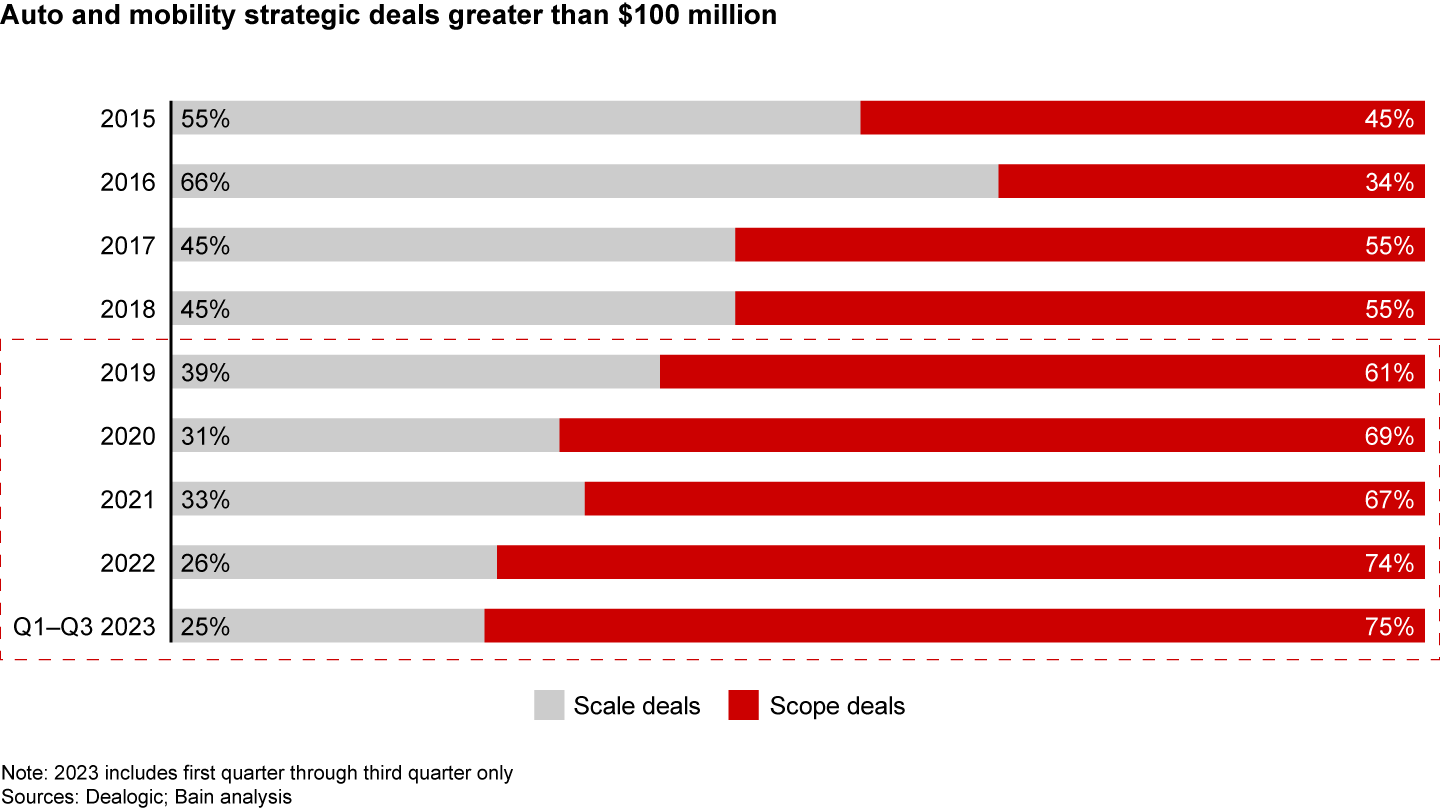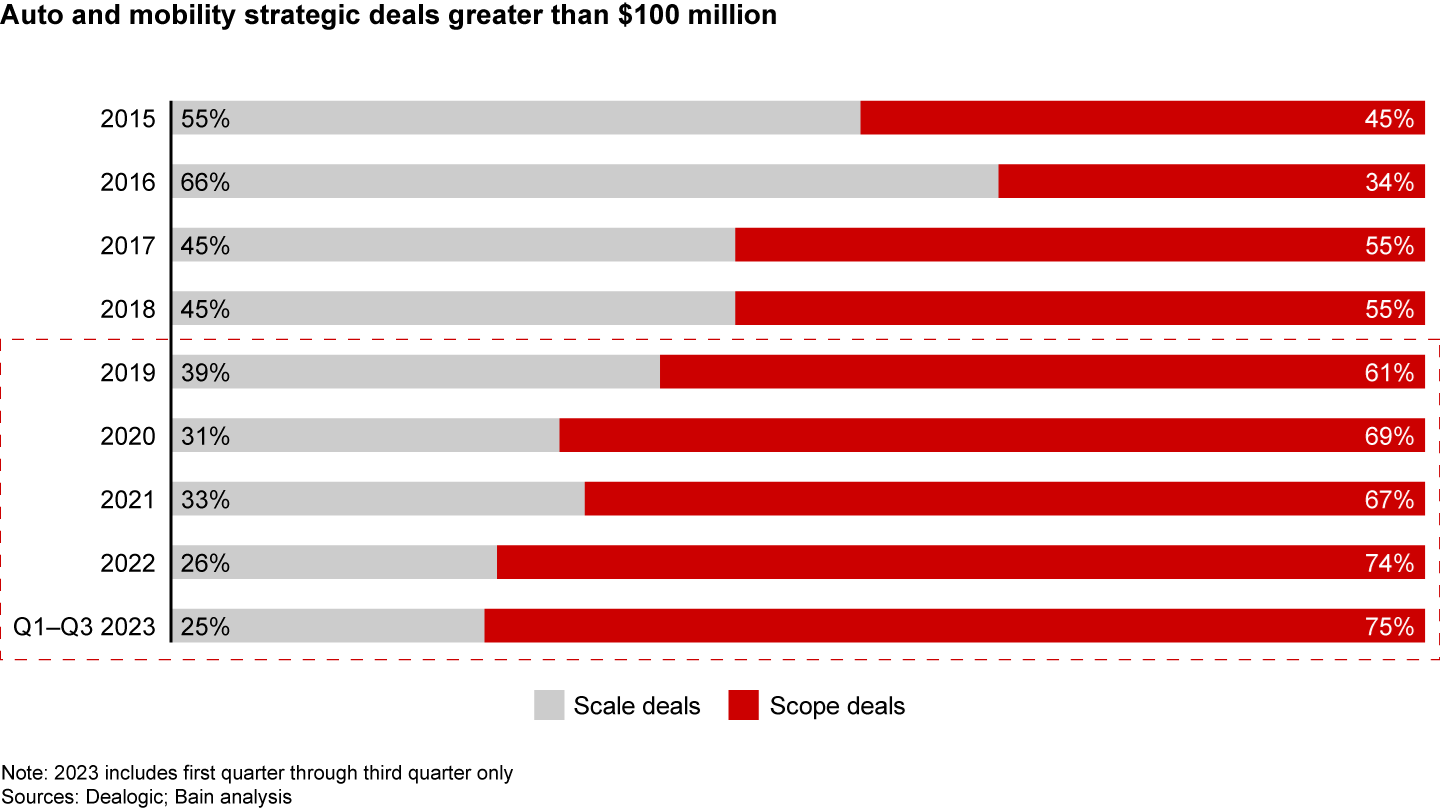M&A Report

At a Glance
- Players pursue M&A to secure access to critical materials for electric vehicles and to create integrated, connected customer ecosystems.
- In 2023, original equipment manufacturers (OEMs) used M&A to move upstream and secure access to the battery value chain.
- Industry transformation is changing the role of OEMs, and M&A remains a relevant tool as direct sales models emerge.
- Looking ahead, internal combustion component businesses will consolidate amid cost pressure and declining volumes.
This article is part of Bain's 2024 M&A Report.
The year 2022 was all about speed as many original equipment manufacturers (OEMs) turned to joint ventures and alliances to hasten the arrival of the future in what we call the “5 RACES”:
- Real customer focus;
- Autonomous driving;
- Connectivity and digitization of vehicles;
- Electrification of powertrains; and
- Shared mobility.
They pursued deals to hasten the development of batteries, vehicle electrification, and advanced driver-assistance systems while preparing their legacy internal combustion engine businesses to either become a steady source of cash or be spun off in favor of investing in tomorrow’s businesses.
Those deals have been effective, and they are continuing. But now, OEMs have encountered big curves in the road that require them to hone their dealmaking skills. Among the biggest is seeking ways of securing access to the critical materials for batteries, including rare earth metals.
Deal activity was muted in 2023 because of the continued uncertain macroeconomic and geopolitical environment, with value dropping by 59% and volume dropping by 40% (see Figure 1). Yet companies across the automotive and mobility value chain have accepted a new fact of life in this industry. M&A was not routinely used by players as a strategic element of their business. Now, as they grapple with new challenges, companies that don’t participate will face a difficult future.
Auto and mobility deal volume increased in the third quarter vs. the previous two quarters, but deal value has fallen since the first quarter
They’ll need deals to help them with two major imperatives:
- the major changes in the automotive value chain resulting from the shift to electrification; and
- the need to build integrated, connected ecosystems with customers—something that requires them to develop entirely new business models.
The unfolding transition to electrification is requiring companies to consider the full array of M&A, from acquisitions to divestitures to restructuring enterprises to steering businesses through joint ventures and partnerships. This is increasing the percentage of scope deals in the auto industry (see Figure 2). As regulations such as the EU’s looming ban on fossil fuel vehicles by 2035 and moves such as the US Inflation Reduction Act generate momentum for electrification, companies are looking for ways to secure their place (and safeguard their profits) in a transition that, until now, has been slower than expected. Finding that security starts by getting the cost for electric vehicles (EVs) right, with batteries as the most expensive item. This holds true for both newly established pure EV players such as Nio, Lucid, and Rivian, as well as established OEMs that must maintain two drivetrain businesses in parallel.
Over the past five years, expanding scope has been the major impetus for strategic M&A deals in the auto and mobility industry


Hence, it is not surprising that in 2023, more OEMs increased their reliance on partnerships and also started moving beyond joint ventures to major investments in companies that can strengthen upstream integration in the battery value chain—making supply chains more regional, reducing the risks of sourcing and producing in China, and even obtaining materials such as lithium on a local basis.
Stellantis invested $100 million in Controlled Thermal Resources, following on its 2022 €50 million investment in Vulcan Energy, to produce lithium in the US and EU. The goal is to build up regional supply chains, making supply more resilient to global crises and geopolitical headwinds. Stellantis is also exploring alternative battery technologies by investing in Lyten to develop lithium-sulfur batteries with a higher energy density and to become independent of nickel, manganese, and cobalt. Other moves include joint ventures aimed at building up production capacities for batteries, which is the objective of the Northvolt and Volkswagen arrangement, or other critical components. The impetus for Ionway, the $2.9 billion battery parts joint venture between Volkswagen’s PowerCo and Belgian materials firm Umicore, was to secure cathode production.
Another way OEMs are securing a future supply of raw materials is through acquisitions or partnerships between battery manufacturers and recycling players. While partnerships have been dominating the landscape so far, Ford has now stepped up the game and invested $50 million in Redwood Materials, a company that will help it in battery dismantling, shredding, and metallurgical refining.
In addition, the shift toward electrification continues to spur both targeted supplier acquisitions and divestitures. Companies are reducing both their dependence on internal combustion engine vehicle components and their development costs for the new EV platform. Renault is partnering with Volvo Trucks to develop electric vans. Schaeffler is planning to acquire Vitesco Technologies to make its portfolio more future ready, forming a new supplier focused on EV powertrain components while benefiting from development cost synergies.
As OEMs invest to secure access to supplies, they also are making deals that would secure distribution and customer access. For example, they’re creating joint ventures to establish integrated and connected customer ecosystems that help deliver new user experiences and, with stronger customer access, increase their share of new direct sales models. Consider how OEMs are partnering with tech companies, in particular, with major mobile phone, software, and telecom players, to create integrated user interface solutions. Apple CarPlay and Android are already standard solutions for in-car connectivity. BMW is partnering with Amazon to develop the carmaker’s next-generation user interface and voice-controlled assistant.
And while OEMs are boosting their efforts to get direct customer access and secure price control, dealers are fighting to maintain and even increase their roles. For example, large dealer groups in the US are acquiring to build scale and therefore solidify their influential positions as favored and indispensable partners for OEMs. In one of the largest auto retailer deals since 2021, Asbury Automotive, one of the US’s largest automotive retail and service companies, bought Koons Automotive, the ninth-largest privately owned dealership group in the US. In another such deal, US group Lithia seeks to buy Pendragon's UK auto retail and leasing operations.
Looking ahead, what can industry players do? The industry will need consolidation beyond dealers. We expect more consolidation of OEMs’ legacy internal combustion engine businesses as companies play out a “last business standing” strategy. It’s the result of both declining internal combustion engine volumes and increasing cost pressures. Rebates are coming back to address below-expectation demand growth, and OEMs will be pushed to maintain profitability and cost. Hence, they will reach out to suppliers, asking for further cost and price reductions. This puts massive pressure on internal combustion engine–focused suppliers, especially in Tiers 2 and 3, to sustain their businesses. Consolidation could serve to aggregate volumes and keep costs down, empowering strategic suppliers to regain decision power over component prices. This will enable them to harvest cash from their mature components business, which can be used to fund the transition to EVs.
Companies throughout the automotive and mobility value chain can follow fundamental M&A hygiene moves to prepare themselves. That means continuing to include a thorough future-back view of their portfolio and developing a well-defined M&A strategy to achieve their goals. This should be standard procedure in any environment, but in such a volatile and rapidly changing world, it’s more critical than ever. Also important: With vertical integration becoming such a decisive factor in the transition to electrification and customer ecosystems, ensure that M&A is embedded in functional strategies as well as corporate strategy. In this industry, in this time, companies can’t afford to view M&A as an ivory tower tool.